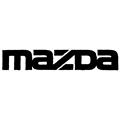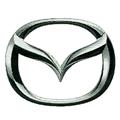The Austrian Supreme Court (short “the Court”) recently ruled that a provider of maintenance and repair services for cars of all brands (short “garage”), including Mazda cars, where that service provider is in no business relationship with the brand owner, may not use figurative marks to indicate its services, but only the word mark (decision of 15.12.2015, 4 Ob 211/15f – Mazda-Logo).
In the decision at issue, the garage had used the following figurative marks in its advertising next to a highway:
Both under the old and the new Trademarks Directive (Art 6(1)(c), respectively, Art 14(1)(c)), as well as under Section 10(3) no. 3 of the Austrian Trademark Act, there is an exception to the trademark owners’ right to prohibit use of its mark for use of a trade mark for the purpose of identifying or referring to goods or services as those of the proprietor of that trade mark, in particular, where the use of the trade mark is necessary to indicate the intended purpose of a product or service, in particular as accessories or spare parts.
In accordance with the ruling of the CJEU in case C-228/03 – Gillette Company and Gillette Group Finland, the Austrian Supreme Court interpretes the exception narrowly. Already in previous cases the Court had held that the exception only applies to the use of word marks, but not to design or figurative marks (e.g. in cases 17 Ob 28/08d – Mazda-Logo, 17 Ob 19/11k – Procter&Gamble, Dr. Best Ersatz-Zahnbürstenkopfe für Oral B. [Dr. Best replacement toothbrushs for Oral B.]), and only under the following conditions:
Use of third party trade marks is only necessary if it is practically the only means of providing the public with comprehensible and complete information on that intended purpose and if the indication of the third party mark is a precondition to preserve effective competition on the market in question.
The use of a figurative or word & device mark is usually not necessary and therefore unlawful in the Court’s view, if the public would also recognize the word mark, or the word element of a word & device mark and associate it with the trade mark owner.
In the present case, the Court confirmed the rulings of the lower instances that the use of the logos (as indicated above) was not the only means of indicating the purpose of the garage’s services, since the public was already familiar with the word mark and also the advertising of the word mark in large letters would have been sufficiently eye-catching.
It should be noted that the cases handed down by the Austrian Supreme Court in this context so far all dealt with trade marks with a (notorious) reputation in Austria. The Court’s emphasis on the fact that the relevant public would already recognize the word mark / word element alone indicates that there may be cases where third party use of design and figurative marks, which have no reputation, may be necessary in order to clearly indicate the intended purpose of the third party goods and services, and thus allowed. However, these cases should be rare: Obviously, the better known a trade mark is, the more likely third parties will use it, and vice versa.
_____________________________
To make sure you do not miss out on regular updates from the Kluwer Trademark Blog, please subscribe here.




